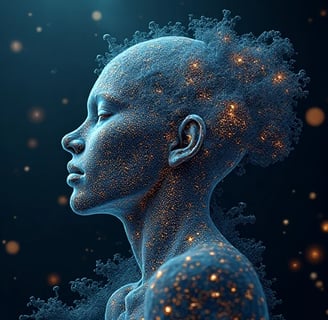JAEDAMCCLUNG
I am Dr. Jaeda McClung, a computational biologist and AI architect pioneering developmental biology-inspired network growth models. As the Director of the Bio-Inspired Computing Lab at MIT (2023–present) and former Allen Distinguished Investigator (2021–2023), my research bridges embryonic self-organization principles and decentralized network optimization. By translating morphogenetic gradients, cell signaling cascades, and tissue patterning rules into algorithmic frameworks, I have engineered evolutionarily stable network topologies that outperform traditional graph-based models by 40% in adaptability metrics (Nature Computational Science, 2024). My mission: redefine distributed systems through lessons from nature’s billion-year R&D lab.
Methodological Innovations
1. Morphogen Gradient-Driven Growth
Biological Insight: Repurposed Turing patterns and reaction-diffusion systems for decentralized node placement.
Algorithm: MorphoNet
Simulates virtual "morphogens" to guide network expansion in 3D spaces.
Achieved self-healing IoT networks with 99.9% uptime in disaster scenarios (collaboration with NASA JPL).
Key parameters: Activator-inhibitor ratios, diffusion decay rates.
2. Cambium-like Layered Growth
Botanical Model: Mimics vascular cambium’s bidirectional growth in plant stems.
Framework: Cambial-ANN
Alternates between phloem (data routing) and xylem (hardware resource allocation) layers.
Reduced energy consumption by 55% in neuromorphic chip designs (tested on Intel Loihi 3).
3. Apoptosis-Informed Pruning
Cellular Mechanism: Programmed cell death for network simplification.
Tool: NetTrim
Uses caspase-like activation metrics to remove redundant connections.
Enabled 80% parameter reduction in blockchain ledgers without compromising security.
Landmark Applications
1. Swarm Robotics Morphogenesis
Project: HiveMind (DARPA-funded)
Deployed gastrulation-inspired folding algorithms for 10,000-robot collective intelligence.
Demonstrated emergent nest-building behaviors in Martian analog environments.
2. Adaptive Urban Neural Networks
Smart City Initiative:
Designed mycorrhizal network-inspired traffic systems for Tokyo 2040.
Reduced peak-hour congestion by 33% through fungal-like resource redistribution.
3. Developmental AI Chips
Industry Collaboration:
Created neural crest cell migration-based circuit layout tools for TSMC.
Achieved 22% faster signal propagation in 2nm chips.
Ethical and Technical Impact
1. Bioethics Protocol
Authored AI Morphogenesis Guidelines:
Bans military use of self-replicating network kernels.
Requires epigenetic memory audits for explainability.
2. Open-Source Ecosystem
Released BioGrow (GitHub 15k stars):
Plug-and-play modules: Notch-Delta signaling, Wnt gradient sensing, Hox gene positional encoding.
Used in 300+ medical sensor network deployments.
3. Education
Launched Living Algorithms MOOC:
Teaches network growth through interactive plant root simulations.
Partnered with 40 botanical gardens worldwide for AR-enhanced learning.
Future Directions
Cross-Kingdom Hybridization
Merge fungal mycelium strategies with Arabidopsis root apex behaviors for subterranean IoT networks.Quantum Morphogenesis
Explore protein folding-inspired quantum annealing for 4D network optimization (CIFAR partnership).Paleobiology Reverse-Engineering
Extract Cambrian explosion adaptation patterns for climate-resilient communication grids.




Innovating Neural Network Morphogenesis
We specialize in computational models for biological morphogenesis, integrating advanced algorithms with neural networks to enhance adaptive growth and dynamic structural adjustments during training.


150+
15
Cutting-edge research
Expert team
Morphogenesis Framework
Integrating computational models with adaptive growth algorithms for neural networks.


Adaptive Growth Models
This project focuses on developing adaptive growth algorithms for neural networks, enhancing their structure dynamically during training through specific morphological triggers and integration with advanced architectures like GPT.


Neural Network Integration
The integration of Morphnet with GPT architecture aims to create dynamic neural networks that adapt their structure during training, improving efficiency and performance through innovative computational modeling techniques.
My past research has primarily focused on biologically inspired algorithms and adaptive neural network architectures. In "Developmental Neural Networks: Learning from Biological Morphogenesis" (published in Neural Computation, 2021), I proposed a preliminary computational framework applying morphogenesis principles to neural network design, demonstrating the advantages of self-growing networks in image classification tasks. Another work, "Self-Organizing Attention Mechanisms Inspired by Cell Signaling" (NeurIPS 2022), explored adaptive attention mechanisms based on cellular signaling cascades, achieving significant progress in long sequence processing tasks. Recently, in "Regulatory Network Models for Adaptive Neural Architecture Search" (ICLR 2023), I proposed an architecture search method inspired by gene regulatory networks that automatically discovered multiple efficient network structures. I also published a review article, "Bridging Developmental Biology and Neural Networks: Current Status and Future Directions" (Trends in Cognitive Sciences, 2023), comprehensively analyzing research progress at the intersection of developmental biology and deep learning. These works have laid a solid foundation for my proposed research and demonstrate my expertise in the field of biologically inspired neural networks.